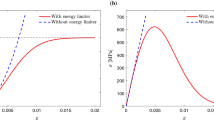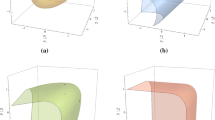Abstract
A new dynamic damage law is proposed for the anti-plane loading case. The model is deduced from the energy criterion describing the dynamic propagation of microcracks by using the mathematical homogenization method based on asymptotic expansions. A study of the local macroscopic response predicted by the new model is conducted to highlight the influence of parameters like the size of the microstructure and the rate of loading on the evolution of damage. Results of macroscopic simulations of dynamic failure and the associated branching instabilities are presented and compared with those reported by experimental observations and theoretical studies on dynamic fracture in brittle materials.

























Similar content being viewed by others
Notes
For simplicity reasons, in what follows the superscript (0) in the notation of the macroscopic fields will be omitted.
References
Adda-Bedia M (2004) Brittle fracture dynamics with arbitrary paths II. Dynamic crack branching under general antiplane loading. J Mech Phys Solids 52:1407–1420
Allix O, Feissel P, Thévenet P (2003) A delay damage mesomodel of laminates under dynamic loading: basic aspects and identification issues. Comput Struct 81:1177–1191
Bhatt H, Rosakis A, Sammis G (2011) A micro-mechanics based constitutive model for brittle failure at high strain rates. J Appl Mech 79(3):1016–1028
Benssousan A, Lions J, Papanicolaou G (1978) Asymptotic analysis for periodic structures. Kluwer, Amsterdam
Bouchbinder E, Goldman T, Fineberg J (2014) The dynamics of rapid fracture: instabilities, nonlinearities and length scales. Rep Prog Phys 77:046501
COMSOL Multiphysics (2015) User’s guide, version 5.2
Dascalu C (2009) A two-scale damage model with material length. C R Mec 337:645–652
Dascalu C (2016) Dynamic localization of damage and microstructural length influence. Int J Damage Mech. doi:10.1177/1056789516651692
Dascalu C (2017) Multiscale modeling of rapid failure in brittle solids: branching instabilities. Mech Mater. http://dx.doi.org/10.1016/j.mechmat.2017.03.008
Dascalu C, Bilbie G, Agiasofitou E (2008) Damage and size effect in elastic solids: a homogenization approach. Int J Solids Struct 45:409–430
Dascalu C, Dobrovat A, Tricarico M (2010a) On a 3D micromechanical damage model. Int J Fract 166:153–162
Dascalu C, François B, Keita O (2010b) A two-scale model for subcritical damage propagation. Int J Solids Struct 47:493–502
Dobrovat A, Dascalu C, Hall S (2015) Computational modeling of damage based on micro-crack kinking. Int J Multiscale Comput Eng 13:201–217
Dubé JF, Pijaudier-Cabot G, La Borderie C (1996) Rate dependent damage model for concrete in dynamics. J Eng Mech 122:939–947
Feng XQ, Gross D (2000) Three-dimensional micromechanical model for quasi-brittle solids with residual strains under tension. Int J Damage Mech 9:79–110
Fish J (2014) Practical multiscaling. Wiley, New York
François B, Dascalu C (2010) A two-scale time-dependent damage model based on non-planar growth of micro-cracks. J Mech Phys Solids 58:1928–1946
Freund LB (1998) Dynamic fracture mechanics. Cambridge University Press, Cambridge
Gambin B, Telega JJ (2000) Effective properties of elastic solids with randomly distributed microcracks. Mech Res Commun 27(6):697–706
Henry H, Levine H (2004) Dynamic instabilities of fracture under biaxial strain using a phase field model. Phys Rev Lett 93(10):105504
Jain JR, Ghosh S (2009) Damage evolution in composites with a homogenization-based continuum damage mechanics model. Int J Damage Mech 18:533–568
Ju JW, Lee X (1991) Micromechanical damage models for brittle materials. J Eng Mech 117:1495–1536
Karma A, Lobkovsky AE (2004) Unsteady crack motion and branching in a phase-field model of brittle fracture. Phys Rev Lett 92(24):245510
Karma A, Kessler DA, Levine H (2001) Phase-field model of mode III dynamic fracture. Phys Rev Lett 87(4):45501
Keita O, Dascalu C, François B (2014) A two-scale model for dynamic damage evolution. J Mech Phys Solids 64:170–183
Lee K, Moorthy S, Ghosh S (1999) Multiple scale computational model for damage in composite materials. Comput Method Appl Mech Eng 172:175–201
Linder C, Raina A (2013) A strong discontinuity approach on multiple levels to model solids at failure. Comput Method Appl Mech Eng 253:558–583
Markenscoff X, Dascalu C (2012) Asymptotic homogenization analysis for damage amplification due to singular interaction of microcracks. J Mech Phys Solids 60:1478–1485
MATLAB Release (2015) The MathWorks, Inc., Natick, MA, USA
Miller O, Freund LB, Needleman A (1999) Energy dissipation in dynamic fracture of brittle materials. Model Simul Mater Sci Eng 7:573–586
Nemat-Nasser S, Obata M (1988) A microcrack model of dilatancy in brittle materials. ASME J Appl Mech 55:24–35
Paliwal B, Ramesh KT (2008) An interacting micro-crack damage model for failure of brittle materials under compression. J Mech Phys Solids 56:896–923
Pandolfi A, Conti S, Ortiz M (2006) A recursive-faulting model of distributed damage in confined brittle materials. J Mech Phys Solids 54:1972–2003
Paulino GH, Yin HM, Sun LZ (2006) Micromechanics-based interfacial debonding model for functionally graded materials with particle interactions. Int J Damage Mech 15:267–288
Prat P, Bazant ZP (1996) Tangential stiffness of elastic materials with systems of growing or closing cracks. J Mech Phys Solids 45:611–636
Rabczuk T, Song J-H, Belytschko T (2009) Simulations of instability in dynamic fracture by the cracking particles method. Eng Fract Mech 76:730–741
Ravi-Chandar K (2004) Dynamic fracture. Elsevier, Boston
Ravi-Chandar K, Knauss WG (1984a) An experimental investigation into dynamic fracture: II. Microstructural aspects. Int J Fract 26:65–80
Ravi-Chandar K, Knauss WG (1984b) An experimental investigation into dynamic fracture: III. On steady-state crack propagation and crack branching. Int J Fract 26:141–154
Ren X, Chen JS, Li J, Slawson TR, Roth MJ (2011) Micro-cracks informed damage models for brittle solids. Int J Solids Struct 48:1560–1571
Sanchez-Palencia E (1980) Non-homogeneous media and vibration theory, vol 127., Lecture notes in physicsSpringer, Berlin
Sharon E, Fineberg J (1999) Confirming the continuum theory of dynamic brittle fracture for fast cracks. Lett Nat 397:333–335
Sharon E, Gross SP, Fineberg J (1996) Energy dissipation in dynamic fracture. Phys Rev Lett 76(12):2117–2120
Spatschek R, Brener E, Karma A (2011) Phase field modeling of crack propagation. Philos Mag 91(1):75–95
Suffis A, Lubrecht TAA, Combescure A (2003) Damage model with delay effect. Analytical and numerical studies of the evolution of the characteristic damage length. Int J Solids Struct 40:3463–3476
Torquato S (2002) Random heterogeneous materials: microstructure and macroscopic properties. Springer, New York
Wang X, Santare MH, Gazonas GA (2009) Anisotropic effective moduli of microcracked materials under antiplane loading. Eng Fract Mech 76:1910–1919
Wang W, Shao JF, Zhu QZ, Xu WY (2015) A discrete viscoplastic damage model for time-dependent behaviour of quasi-brittle rocks. Int J Damage Mech 24:21–40
Willoughby N, Parnell WJ, Hazel AL, Abrahams ID (2012) Homogenization methods to approximate the effective response of random fibre-reinforced composites. Int J Solids Struct 49:1421–1433
Wrzesniak A, Dascalu C, Besuelle P (2015) A two-scale time-dependent model of damage: influence of micro-cracks friction. Eur J Mech A Solids 49:345–361
Xu X-P, Needleman A (1994) Numerical simulation of fast crack growth in brittle solids. J Mech Phys Solids 42(9):1397–1434
Zhang Z, Paulino GH, Celes W (2007) Extrinsic cohesive modelling of dynamic fracture and microbranching instability in brittle materials. Int J Numer Methods Eng 72:893–923
Zhou F, Molinari JF, Shioya T (2005) A rate-dependent cohesive model for simulating dynamic crack propagation in brittle materials. Eng Fract Mech 72:1383–1410
Author information
Authors and Affiliations
Corresponding author
Rights and permissions
About this article
Cite this article
Atiezo, M.K., Dascalu, C. Antiplane two-scale model for dynamic failure. Int J Fract 206, 195–214 (2017). https://doi.org/10.1007/s10704-017-0208-0
Received:
Accepted:
Published:
Issue Date:
DOI: https://doi.org/10.1007/s10704-017-0208-0




